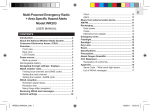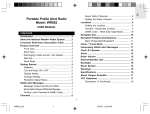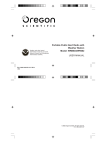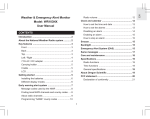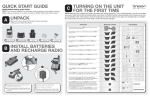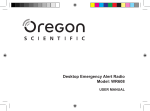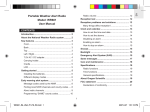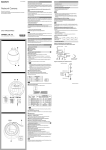Download Portable Public Alert Radio with Weather Station
Transcript
USER MANUAL CONTENTS Introduction .......................................................... 3 Product Overview ................................................ 4 Weather Station WRB603 – Front View ............... 4 Weather Station WRB603 – Back View ................ 4 Weather Station WRB603 – LCD ........................ 5 Remote Sensor RTGR328NA – Front View ......... 5 Remote Sensor RTGR328NA – LCD ................... 5 Remote Sensor RTGR328NA – Back View .......... 5 Radio WR602 – Front View .................................. 6 Radio WR602 – Back View .................................. 7 Radio WR602 – Belt Clip ..................................... 7 Radio WR602 – Neck Strap ................................. 7 Getting Started ..................................................... 8 Batteries .......................................................... 8 AC / DC Adapter ................................................ 9 Remote Sensor RTGR328NA ................................ 9 Set Up Sensor ....................................................... 9 Data Transmission ................................................10 1 WRB603_EN_R0 1 27/6/07, 3:31 PM EN Search for Sensor .............................................. 10 Weather Station WRB603 ......................................... 10 Atomic Clock ..................................................... 11 Time Zones ....................................................... 11 Turn Atomic Clock ON / OFF ............................. 11 Set Clock ............................................................ 12 Switch Clock Display ........................................ 12 Alarm ................................................................. 12 Weather Forecast Display ................................. 13 Temperature and Humidity ................................ 13 Radio WR602 ............................................................. 14 About the National Weather Radio System ...... 14 Consumer Electronics Assoc. (CEA) ................ 14 Turn the Radio ON / OFF ................................ 14 Display Modes ................................................... 14 Change Settings ................................................ 15 Reception Signal Status .................................... 15 NOAA Alert Messages WR602 ................................ 16 Message Codes Used by the NWR .................... 16 Set Up Radio To Receive NOAA Alert Messages ...... 16 Finding Local Channels & Same Codes ......... 16 Radio WR602 – Channels ........................................ 17 About Radio Channels ....................................... 17 Setting the Radio Channel ................................. 17 Radio WR602 – Locations ....................................... 18 Setting the Location ........................................... 18 Activate / Deactivate Location .......................... 18 Portable Public Alert Radio with Weather Station Model: WRB603/WR602 EN SAME Code – What Each Digit Means .............. 19 Reception Test ........................................................... 20 Reception Problems And Solutions ....................... 20 Many Things Attect Reception! ........................... 20 Radio WR602 – Home / Travel Feature ................. 20 Radio WR602 – Interpreting NOAA Alert Messages .. 21 Radio WR602 – Clock & Calendar ....................... 25 Radio WR602 – Alarm ................................... 25 Radio WR602 – Volume ......................................... 25 Radio WR602 - External Speaker Jack .................. Backlight ................................................. Reset System .......................................... Warnings ................................................... Specifications ............................................. About Oregon Scientific ............................... FCC Statement ........................................ 26 26 26 26 27 28 28 2 WRB603_EN_R0 2 27/6/07, 3:31 PM EN INTRODUCTION Thank you for selecting the Oregon ScientificTM Portable Public Alert Radio with Weather Station (WRB603/ WR602). This radio (WR602) operates on the same radio frequencies used by the National Weather Radio (NWR) and can send you NOAA alert messages to warn you about weather and other environmental dangers. This lightweight, splashproof radio is constructed of durable materials and has a reception range of up to 50 miles (64 km). It is also equipped with a digital clock and daily alarm. The weather station (WRB603) forecasts the weather, provides indoor / outdoor temperature and humidity readings, a clock, calendar and alarm, as well as a recharging cradle for the radio. The remote sensor (RTGR328NA) sends the atomic clock signal and outdoor temperature and humidity information to the weather station. Keep this manual handy as you use your new product. It contains practical step-by-step instructions, as well as technical specifications and warnings you should know. 3 WRB603_EN_R0 3 27/6/07, 3:31 PM EN PRODUCT OVERVIEW 8. 9. 10. 11. WEATHER STATION WRB603 - FRONT VIEW Temperature / Humidity Area Clock / Alarm / Calendar Area Recharging cradle LED indicator: Shows red when radio is charging WEATHER STATION WRB603 - BACK VIEW 1. SNOOZE / LIGHT button 2. / : Increase or decrease setting; activate or deactivate RF clock CHANNEL: Switch between remote sensors MODE: Change display / settings MEMORY: View current max. / min. temperature and humidity readings 3. 4. 5. 6. 7. 1. 2. 3. °C / °F switch RESET hole AC / DC adapter : Display alarm time; enter alarm setting mode Weather Forecast Area 4 WRB603_EN_R0 4 27/6/07, 3:31 PM 1. LCD display 2. LED status indicator 3. Ventilation duct REMOTE SENSOR RTGR328NA – LCD 1. US time zone indicator 2. Reception 3. Channel no. 4. Low battery indicator 5. Time 6. Temperature (°C or °F) 7. Relative humidity 1. 2. 3. 4. 5. 6. 7. 8. 9. 10. 11. 12. Weather display Alarm 1 Alarm 2 Atomic clock signal status Time / alarm time / calendar Low battery icon for remote sensor Channel no. / reception status Outdoor temperature Outdoor humidity Indoor area icon Indoor temperature Indoor humidity 8. Temperature / humidity reading REMOTE SENSOR RTGR328NA – BACK VIEW 1. Wall mount (recess hole) 2. Channel 3. RESET 4. °C/°F 5. SEARCH 6. ZONE 7. Battery compartment 8. Fold-out stand 5 WRB603_EN_R0 5 27/6/07, 3:31 PM EN REMOTE SENSOR RTGR328NA – FRONT VIEW WEATHER STATION WRB603 - LCD EN RADIO WR602 – FRONT VIEW 1. 2. 3. 4. 5. 6. 7. 8. 9. LCD TR / HM: Press and hold to select travel or home mode EXIT: Press to exit any display or setting (clock is default setting) / : Increase / decrease settings; increase / decrease volume; enable / disable alarm 1 or 2; scroll up or down to select county code LED indicator: Red / green LED indicates radio ON / OFF and alert status : Press and hold to activate / deactivate keypad lock : Press to toggle between NOAA alert messages MENU: Press to switch between clock, calendar, alarm 1 and 2 displays; press and hold to enter setting mode Radio speaker 6 WRB603_EN_R0 6 27/6/07, 3:31 PM RADIO WR602 – NECK STRAP 1. 2. Antenna Neck strap: Insertion point for neck strap 3. : Press to activate 8-minute snooze and / or backlight for 5 seconds 4. : Press and hold to turn power ON / OFF; press to switch between NOAA ON / Standby / Mute / OFF modes External speaker jack RESET hole Battery compartment 5. 6. 7. WRB603_EN_R0 7 7 27/6/07, 3:31 PM EN RADIO WR602 – BELT CLIP RADIO WR602 – BACK VIEW EN REMOTE SENSOR 2 x UM-3 (AA) 1.5V batteries GETTING STARTED BATTERIES RADIO (WR602) Rechargeable batteries are included and must be used if you want to use the recharging cradle. However, the radio can use 3 x UM-3 (AA) 1.5V batteries. Insert the rechargeable battery by putting the piece at the end of the wire into the indentation at the bottom right of the battery compartment: Insert batteries before first use, matching the polarity (+ and -) as shown in the battery compartment. Press RESET after each battery change. shows when batteries are low. UNIT Remote sensor LOCATION Outdoor Temperature / Humidity Area NOTE Do not use rechargeable batteries in the remote sensor. It is recommended that you use alkaline batteries with this product for longer performance and lithium batteries in colder climates. Please dispose of used batteries properly to prevent harm to the environment. 8 WRB603_EN_R0 8 27/6/07, 3:31 PM 5. 6. 7. Insert the batteries. Set the measurement unit (°F or °C) and select the US time zone – Pacific (P), Mountain (M), Central (C) and Eastern (E). Press RESET. Replace and secure the battery compartment lid. Secure the sensor in the desired location using the wall mount or table stand. REMOTE SENSOR (RTGR328NA) This remote temperature-humidity sensor can receive and transmit atomic clock signals, collect outdoor temperature and humidity readings, and then relay them back to the weather station. It can be used with up to 4 other remote temperature-humidity sensors. NOTE Additional remote sensors that measure temperature and humidity are sold separately. SET UP SENSOR 1. Open the battery compartment with a small Phillips screwdriver. 2. Set the channel number (1-5). If you are using more than one remote unit, select a different channel number for each unit WRB603_EN_R0 9 For best results: • Insert the batteries and select the channel before you mount the sensor. • Place the sensor out of direct sunlight and moisture. • Do not place the sensor more than 98 feet (30 meters) from the weather station. 9 27/6/07, 3:31 PM EN 3. 4. AC / DC ADAPTER Insert the adapter into the weather station to turn it on and allow charging for the radio. EN • • • Position the sensor so that it faces the weather station, minimizing obstructions such as doors, walls, and furniture. Place the sensor in a location with a clear view to the sky, away from metallic or electronicobjects. Position the sensor close to the weather station during cold winter months as below-freezing temperatures may affect battery performance and signal transmission. DATA TRANSMISSION Data is sent from the sensor approx. every 60 seconds. The reception icon shown in the Outdoor Temperature / Humidity Area indicates the status. ICON DESCRIPTION Main unit is searching for sensors Selected sensor has been found You may need to experiment with various locations to get the best reception. --- shows in Temp / Humidity Area Standard Alkaline batteries contain significant amounts of water. Because of this they will freeze in low temperatures of approximately 10°F (-12°C). Disposable lithium batteries have a much lower threshold for temperature with an estimated freezing range of below -40°F (-40°C). The Liquid Crystal Display in outdoor thermometers will remain operational to -20°F (-28°C) with adequate power. Sensor 1 is sending data. (The number shows which sensor is selected) The selected sensor cannot be found. Search for the sensor or check batteries SEARCH FOR SENSOR To search for the temperature-humidity sensor, simultaneously press and hold MEMORY and CHANNEL on the weather station. Wireless ranges can be impacted by a variety of factors such as extremely cold temperatures. Extreme cold may temporarily reduce the effective range of the unit. If the unit’s performance fails due to low temperature, the unit will resume proper functioning as the temperature rises to within the normal temperature range (i.e. no permanent damage will occur to the unit due to low temperatures). NOTE If the sensor is not found, check the batteries. WEATHER STATION WRB603 This product tracks the time and date based on radiocontrolled signals from the RTGR328NA sensor or manual settings that you enter. 10 WRB603_EN_R0 10 27/6/07, 3:31 PM The unit has lost contact with the remote sensor and the time is not synchronized The unit cannot reach the remote sensor Initial reception takes 2-10 minutes, and is initiated when you first set up the sensor, and whenever you press RESET. If the RF signal is weak, it can take up to 24 hours to get a valid RF signal reception. Once complete, the reception icon will stop blinking. NOTE To force a manual search for atomic clock reception, press and hold SEARCH on the sensor for 2 seconds. TIME ZONES When the main unit receives an atomic clock signal (via the sensor) for the first time, or when you force a manual search for the atomic clock reception, the time will automatically be set to Pacific time. To change to another time zone (M - Mountain, C - Central or E- Eastern) simply icon shown in the Clock Area indicates 2 The factors: • Connection between the weather station and the sensor that collects atomic clock signals ( • Atomic clock signal reception ( ) ) How these signals work together: ICON MEANING The unit has contact with the sensor and has synchronized the time 11 11 Press and hold MODE for 2 seconds. 2. Press or 3. Press to confirm and exit setting mode. to change the setting. TURN ATOMIC CLOCK ON / OFF If you wish to manually set the clock, you must first disable the atomic clock feature. To do this, press and The unit has contact with the sensor but the time has not been synchronized WRB603_EN_R0 1. hold on the weather station for 2 seconds. To enable 27/6/07, 3:31 PM EN The unit has lost contact with the remote sensor but the time is synchronized ATOMIC CLOCK The sensor automatically synchronizes the current time and date on the clock when it is brought within range of the WWVB-60 atomic clock signal generated from Fort Collins, Colorado. For more information, please visit: www.boulder.nist.gov/timefreq.stations/radioclocks.htm The signals are collected by the remote sensor whenever it is within 932 miles (1500 km) of a signal. EN Clock with Weekday and Calendar display. it, press and hold for 2 seconds. This icon , will only appear on the display when the atomic clock is enabled. ALARM This product is equipped with 2 alarms. SET CLOCK You only need to do this if you have disabled the atomic clock, or if you are too far from the atomic clock signal. 1. Press and hold MODE for 2 seconds. 2. Press or to change the setting. (Press and hold to scroll quickly through the options.) Press MODE to confirm and move onto the next one. The settings will appear in the following order: Time zone, 12 / 24 hour format, hour, minute, year, month / day format, month, date, and display language. 3. 4. To view alarm settings: Press to toggle between alarm 1, alarm 2 and clock display. The alarm time and status will show in the Clock Area. To set the alarm: NOTE The time zones available are P (Pacific), M (Mountain), C (Central) and E (Eastern). 1. once to select alarm 1 and twice to select Press alarm 2. 2. Press and hold mode. 3. The alarm settings will blink. Press or to change settings – hour and minute. (Press and for 2 seconds to enter setting hold to scroll quickly through the options.) Press to confirm. NOTE The language options are E (English), F (French) and S (Spanish). The language you select determines the weekday display. To activate or deactivate the alarm: SWITCH CLOCK DISPLAY Press MODE to toggle between Clock with Seconds, or to activate or deactivate alarm 2. Then press the alarm. • “-:--“ appears when the alarm is deactivated. Press once to select alarm 1 and twice to select 12 WRB603_EN_R0 12 27/6/07, 3:31 PM • Outdoor data is collected and displayed approx. every 60 seconds. Indoor data is collected and displayed every 10 seconds. To silence the alarm: When the alarm time is reached, the crescendo alarm will sound for 2 minutes. To silence the alarm: • • To select temperature unit: Slide the °C / °F switch into the desired location. The switch is located on the back of the weather station. The setting for the weather station overrides the remote sensor setting. Press SNOOZE to silence it for 8 minutes. OR Press any key on the weather station except SNOOZE to mute the alarm and activate it again after 24 hours. To select channel: Press CHANNEL to switch between sensors 1-5. If no button is pressed, the alarm will automatically silence after 2 minutes. It will then sound again after 8 minutes. The icon shows the selected sensor: INDOOR WEATHER FORECAST DISPLAY This product forecasts the next 12 to 24 hours of weather within a 30-50 km (19-31 mile) radius with 70 to 75 percent accuracy. The weather forecast is always displayed. SUNNY PARTLY CLOUDY RAINY CHANNEL CHANNEL CHANNEL 1 2 3 CHANNEL 4 CHANNEL 5 To auto-scan between sensors: Press and hold CHANNEL for 2 seconds. Each sensor's data will be displayed for 3 seconds. To end auto-scan, press CHANNEL or MEMORY. SNOWY NOTE If you use a sensor that collects only temperature data, humidity will not be shown. TEMPERATURE AND HUMIDITY This product can display current, minimum, and NOTE WRB603_EN_R0 13 13 27/6/07, 3:31 PM EN maximum temperatures and humidity percentage information collected by the remote sensor(s) and weather station (indoor). or shows in the Clock / Alarm Area when the alarm is activated. EN forecast, regional conditions and marine forecasts. Additional information, including river stages and climatic data, is also provided. During emergencies, these routine broadcasts are interrupted to report specific warnings. For more information on the sensor see Remote Sensor section. To view minimum / maximum records: Press MEMORY to toggle between current, maximum (MAX) and minimum (MIN) records. To clear the records, press and hold MEMORY for 2 seconds. A beep will sound to confirm that the memory has been cleared. CONSUMER ELECTRONICS ASSOC. (CEA) This product complies with the Consumer Electronics Association (CEA) testing standards. To force a manual search for the sensor: Press and hold CHANNEL and MEMORY. See Atomic Clock section for how to check the signal status. TURN THE RADIO ON / OFF RADIO WR602 When the unit is first connected to the battery pack or reset, on it will immediately enter the clock / language setting mode (see Change Settings section). It is advisable to set your preferred language English (E), French (F) or Spanish (S) at this time, so you can read the NOAA alert messages. To turn the radio ON / OFF, press and hold ABOUT THE NATIONAL WEATHER RADIO SYSTEM The National Weather Service (NWS) is an agency within the National Oceanic & Atmospheric Administration (NOAA) that operates a nationwide network of radio stations known as the NOAA Weather Radio (NWR). The NWR radio system broadcasts warning information for all types of hazards, both natural and technological. Working in conjunction with the Emergency Alert System (EAS), NWR is an all-in-one hazards radio network and is considered to be the single source of all comprehensive weather and emergency information. DISPLAY MODES There are 2 display modes: 1. Clock mode 2. Radio status mode To switch between the clock mode displays, press MENU. A nationwide network, the NWR consists of more than 800 stations in the United States, Puerto Rico, the US Virgin Islands and US Pacific Territories. Broadcasts are designed to meet local needs. Routine programming is repeated every few minutes and consists of local 14 WRB603_EN_R0 14 . 27/6/07, 3:31 PM To switch between the radio status mode displays, press . 2. Press or to scroll through the setting options (Set Alarm / Set Clock / Set Channel / Set Location) and press MENU to select the desired one. 3. Use or to change a setting, then press MENU to confirm and move onto the next one. Press EXIT to leave the setting mode at any time. 4. NOTE To reach a number quickly, press and hold or . RECEPTION SIGNAL STATUS To check the status of the reception signal, look at the reception icon on the display. ICON DESCRIPTION Current selected channel signal is strong Current selected channel signal is weak No NOAA alert message has been received for 10 days. Current selected channel signal is weak No NOAA alert message has been received for 10 days. Current selected channel signal is strong NOTE Leaving the radio in NOAA ON mode will consume substantially more power. To save power, set the unit to NOAA Standby when you are not listening to radio broadcasts. 15 WRB603_EN_R0 15 27/6/07, 3:31 PM EN CHANGE SETTINGS To change, clock, alarm, channel and location settings: 1. Press and hold MENU for 2 seconds to enter setting mode. EN NOTE When the radio is set to NOAA ON, Standby or Mute, it will continually search for a NOAA signal. • NOAA ALERT MESSAGES WR602 MESSAGE CODES USED BY THE NWR When the NWR airs urgent warnings, a digital code known as Specific Area Message Encoding (SAME) is included as part of the message. This coding system contains specific information including the localized geographical area affected and the expiration time of the message. The WR602 retrieves and interprets SAME code messages and alerts the user. When SAME codes for a specific region have been entered into the unit, the unit alerts the user to relevant warning information for the specified region. Once alerted, a voice broadcast can be heard. • Turning the radio off by setting it to Standby, Mute or OFF will help to save power. FINDING LOCAL CHANNELS & SAME CODES The codes are subject to change. Therefore, to ensure successful operation you must obtain the most appropriate, up-to-date NWR radio channels and SAME codes for a specific county or region, from the contact details listed below. SET UP RADIO TO RECEIVE NOAA ALERT MESSAGES To receive a NOAA alert message, press radio to one of the following options: To contact the NWS by telephone: 1. Phone 1-888-NWR-SAME (1-888-697-7263). 2. Follow prompts through a simple voice menu. to set the • Radio ON [ ]: The radio is ON and voice messages can be heard continuously. • Radio Standby [ ]: The radio is in Standby and will switch to ON when a NOAA alert message is received. Radio Mute [ ]: The radio is in Standby with the sound turned OFF. NOAA alert messages can be viewed but not heard. Switch the radio ON to hear messages. Radio OFF: The radio is turned OFF and will not respond to NOAA alert messages. To obtain NWS radio channels and SAME codes on the internet: 1. Locate www.nws.noaa.gov/nwr/indexnw.htm 2. Click the State for which information is needed. For example, clicking on “Montana” will give a list of information relevant to the State of Montana including 16 WRB603_EN_R0 16 27/6/07, 3:31 PM RADIO WR602 – CHANNELS ABOUT RADIO CHANNELS The NWR radio channels work in the same way as a regular radio channel. All of the NWR transmission stations operate on 1 of 7 frequencies. CHANNEL CORRESPONDING RADIO FREQUENCY 1 162.400 MHz 2 162.425 MHz 3 162.450 MHz 4 162.475 MHz 5 162.500 MHz 6 162.525 MHz 7 162.550 MHz A Auto – the unit will tune to the strongest RF signal available Example of the first 10 county radio channels and SAME codes for Montana. COUNTY/ CITY/AREA SAME# NWR TRANSMITTER FREQ. Beaverhead 030001 Butte, MT 162.550 WXL79 Beaverhead 030001 Dillon, MT Big Horn 030003 Billings, MT 100 162.475 WXG638 150 162.550 WXL27 300 Blaine 030005 Havre, MT 162.400 WXL53 300 Blaine 030005 Malta, MT 162.475 WWG85 100 Broadwater 030007 Helena, MT 162.400 WXK66 1000 Carbon 030009 Billings, MT 162.550 WXL27 300 Carter 030011 Baker, MT 162.550 WXK57 300 Cascade 030013 Great Falls, MT 162.550 WXJ43 300 Choteau 030015 BelgianHill, MT 162.500 WWG84 300 CALL WATTS REMARKS N NOTE Many counties have been subdivided into as many as 9 smaller subsections. The numbers 1-9 in the far left column of the SAME code identifies specific subsections of a county. If a county has not been subdivided, the first digit of the SAME code will be 0. The unit labels each frequency as a channel (1-7 or Auto). Once the radio frequency for a region has been selected the unit will receive voice and code information from that station. The channel number in use can be viewed on the top lefthand corner of the LCD. SETTING THE RADIO CHANNEL To change the radio channel, navigate to “Set Channel” setting mode and select the desired Channel, as shown in the Changing Settings section. 17 WRB603_EN_R0 17 27/6/07, 3:31 PM EN the names of counties, SAME codes, NWR transmitter locations, the frequency of the transmitter, the strength of the signal in WATTS, and any remarks as applicable. EN • RADIO WR602 – LOCATIONS SETTING THE LOCATION You need to set the location so that you can receive weather and environmental information for an area that is relevant to you. If you select “FIPS” you need to enter the 6-digit SAME code of your chosen location and then press EXIT (see Finding Local Channels & SAME Codes section for how to obtain a SAME code). NOTE If at step 2 you select “C0:All” you will receive all warnings within the unit’s reception range. This may result in giving you information for regions that is not relevant. The regions can be as large as 5,000 square miles (13 sq km). If you select “CO:----“ you will disable the ALL option and will only receive warnings from specified local areas. You can choose the location by either the state and county name, or FIPS code. Up to 9 locations (1-9) can be stored. NOTE If you do not set a location, the radio will use the default setting “CO:All” for all counties. NOTE Once the location name is selected, the corresponding FIPS code will be set into the memory. You cannot convert the code back to the location name. (FIPS is the Federal Information Processing System number assigned to each State, or open waters in or around the US. The SAME code comprises of numbers generated by the FIPS system.) To set the location: 1. Navigate to “Set Location” setting mode as shown in the Changing Settings section. 2. Select where you want to store the location e.g. C1. 3. Select the 6-digit number e.g. “000000”. (“----” means the location is disabled.) 4. Select “Name” or “FIPS”. • If you select “Name” you can select first the State and then the County of your chosen location, then press EXIT. (If you wish to receive State-wide NOAA messages, press EXIT once you have selected the State.) ACTIVATE / DEACTIVATE LOCATION You can activate / deactivate 1, some, or all of your stored locations. When a location is activated, the 6-digit SAME code can be viewed in your stored locations display. When a location is deactivated, “----” can be viewed in your stored locations display. 18 WRB603_EN_R0 18 27/6/07, 3:31 PM Then when “000000” or “----“ is blinking, press NOTE If the county sub-section code is stated as 0, then that county is not sub-divided and all alerts for that county will be received. To receive all of the alerts for a given county, insert 0 into the county sub-section. or to activate or deactivate it and press EXIT to confirm the setting. SAME CODE – WHAT EACH DIGIT MEANS A SAME code is broken into six fields of numbers. 3 04 A county can be subdivided as follows: 1 Northwest 2 North Central 3 Northeast 4 West Central 5 Central 6 East Central 7 Southwest 8 South Central 9 Southeast 003 Code for Cochise County Code for Arizona Code for northeast sub-section of Cochise County County Code of Cochise County, Arizona State-county coding: The 3 digits on the far right refer to the state county coding. Each county within a state will have an independent 3-digit code. NOTE To receive all of the alerts for a given state, insert 000 into the county section. State codes: Moving towards the left, the next 2 digits are for state 1 2 3 4 5 6 7 8 9 19 WRB603_EN_R0 19 27/6/07, 3:31 PM EN coding. Each of the 50 US states has their own 2-digit code. County sub-section code: The last digit on the extreme left is the county subsection. A county may be subdivided into 9 subsection; each number between (1-9) represents a specific county sub-section. To switch between activated or deactivated location status: 1. Navigate to “Set Location” setting mode as shown in the Changing Settings section. 2. Select a stored location e.g. C4 and press MENU. EN RECEPTION TEST The fact that you can get clear voice reception does not guarantee that an emergency alert will trigger your unit’s alert tone. To test actual reception, your unit must receive a test or emergency alert signal broadcast. The National Weather Service (NWS) broadcasts a test alert every week on Wednesday between 11AM and 12PM (noon). To find out the specific test schedule in your area, contact your local National Oceanic and Atmospheric Administration (NOAA) or National Weather Service (NWR) office. These offices are usually listed in the telephone book under “US Government”. RADIO WR602 – HOME / TRAVEL MODE When the unit is set to home mode, the NOAA radio will lock on the channel according to the Channel settings. When the unit is set to travel mode, the NOAA radio will lock on the channel according to the setting. If the signal strength is weak, the unit will switch to another channel that has a good signal. The location will be set to “C0:All”. Therefore, in travel mode, you will not always receive relevant NOAA alert messages, but it does mean that you can receive warning information when you are traveling outside your home area. REMEMBER For your system to be effective, you must place the emergency radio in a location where it can receive an emergency alert signal, you can hear its siren, and see its flashing indicator lights. To switch between travel and home mode, press and hold TR / HM. RECEPTION PROBLEMS AND SOLUTIONS MANY THINGS AFFECT RECEPTION! Forests, deserts, and hills / mountains tend to greatly reduce reception. Reception in cities may be reduced due to steel and concrete, while higher elevations will enhance the signal. Reception can vary from room to room. Moving even a few feet can enhance signal reception. RECOMMENDATION Place the your weather radio near a window, away from other electronic equipment, and on an upper level of your house. 20 WRB603_EN_R0 20 27/6/07, 3:31 PM Additionally, to help you check that your radio is set-up and working properly, your local NOAA will release a Test NOAA message every Wednesday between 10am and noon, local time. To receive the Test message make sure that your radio is set to NOAA ON, NOAA Standby or NOAA Mute mode, that a Channel has been selected and a SAME code programmed in. If you have any questions regarding alarm tests or to verify if a test was conducted, contact the programming office of your local NOAA Weather Radio station. To view NOAA alert messages, press . For more information on how to interpret the NOAA alert messages, please refer to the list of National Events and Messages below: NATURE OF ACTIVATION Administrative Message Avalanche Watch Avalanche Warning Biological Hazard Warning Boil Water Warning Blizzard Warning Child Abduction Emergency Civil Danger Warning Civil Emergency Message Coastal Flood Watch Coastal Flood Warning Chemical Hazard Warning Contaminated Water Warning WRB603_EN_R0 SPANISH Mensaje administrativo Vigilancia de avalancha Aviso de avalancha Aviso de riesgo biológico Aviso de hervir agua Aviso de ventisca Emergencia de secuestro de menores Aviso de peligro civil Mensaje de emergencia civil Vigilancia de inundaciones costeras Aviso de inundaciones costeras Aviso de riesgo químico Alerta de Agua Contaminada 21 21 FRENCH Message administratif Veille d'avalanche Alerte d'avalanche Alerte risque biologique Alerte d'ébullition de l'eau Alerte de blizzard Alerte de rapt d'enfant Alerte de danger civil Message d'urgence civile Veille d'inondation côtière Alerte d'inondation côtière Alerte de risque chimique Alerte de contamination de l'eau 27/6/07, 3:31 PM MESSAGE ADVISORY WATCH WARNING WARNING WARNING WARNING ADVISORY WARNING WARNING WATCH WARNING WARNING WARNING EN RADIO WR602 - INTERPRETING NOAA ALERT MESSAGES This product is equipped to receive all required NOAA and Emergency Alert System (EAS) events. When an EAS event is sent by the NWS, any 1 of the following NOAA alert messages will be displayed on your radio: “WARNING”, “WATCH”, or “ADVISORY”. The unit can store up to 8 NOAA alert messages. EN Dam Watch Dam Break Warning Contagious Disease Warning Practice / Demo Dust Storm Warning Emergency Action Notification Emergency Action Termination Earthquake Warning Immediate Evacuation Evacuation Watch Food Contamination Warning Flash Flood Watch Flash Flood Statement Flash Flood Warning Flood Watch Flood Statement Flood Warning Fire Warning Flash Freeze Warning Freeze Warning Hurricane Statement Hazardous Materials Warning Hurricane Watch Hurricane Warning High Wind Watch High Wind Warning Vigilancia de represa Veille de barrage Aviso de rompimiento de represa Alerte de rupture de barrage Aviso de enfermedad contagiosa Alerte de maladie contagieuse Práctica/Demostración Exercice/démonstration Aviso de vendaval de polvo Alerte de tempête de poussière Anuncio de acción urgente Notification d'action urgente Fin de acción urgente Fin d'action urgente Aviso de terremoto Alerte de tremblement de terre Evacuación inmediata Évacuation immédiate Vigilancia de evacuación Veille d'évacuation Aviso de contaminación de alimentos Alerte de contamination d'aliments Vigilancia de inundaciones relámpago Veille de crue subite Advertencia de inundaciones relámpago Bulletin spécial de crue subite Aviso de inundaciones relámpago Alerte de crue subite Vigilancia de inundación Veille d'inondation Advertencia de inundación Bulletin spécial de risque d'inondation Aviso de inundación Alerte d'inondation Aviso de incendio Alerte de feu Aviso de helada repentina Alerte de gel soudain Aviso de helada Alerte de gel Advertencia de huracán Avis d'ouragan Aviso de materiales peligrosos Alerte de matières dangereuses Vigilancia de huracán Veille d'ouragan Aviso de huracán Alerte d'ouragan Vigilancia de vientos fuertes Veille de coup vent Aviso de vientos fuertes Alerte de coup vent 22 WRB603_EN_R0 22 27/6/07, 3:31 PM WATCH WARNING WARNING ADVISORY WARNING WARNING STATEMENT WARNING WARNING WATCH WARNING WATCH ADVISORY WARNING WATCH ADVISORY WARNING WARNING WARNING WARNING ADVISORY WARNING WATCH WARNING WATCH WARNING 23 WRB603_EN_R0 23 27/6/07, 3:31 PM WARNING WARNING ADVISORY WARNING WARNING ADVISORY ADVISORY ADVISORY ADVISORY ADVISORY WARNING ADVISORY WARNING ADVISORY ADVISORY WARNING ADVISORY WARNING WATCH WARNING ADVISORY WATCH ADVISORY WARNING WATCH WARNING EN Iceberg Warning Aviso de témpano de hielo Alerte d'iceberg Industrial Fire Warning Aviso de incendio industrial Alerte de feu industriel Local Area Emergency Emergencia de área local Urgence locale Law Enforcement Warning Aviso de las autoridades de la ley Alerte des forces de l'ordre Land Slide Warning Aviso de deslizamiento de tierra Alerte de glissement de terrain National Audible Test Prueba nacional de audibilidad Essai Audible National National Information Center Mensaje del NationalInformation Center Message du centre national d'information Network Notification Anuncio de mensaje en red Notification de message réseau National Periodic Test Prueba periódica nacional Essai périodique national National Silent Test Prueba nacional de silencio Essai national de silence Nuclear Power Plant Warning Aviso de riesgo nuclear Alerte de centrale nucléaire Power Outage Advisory Notificación de interrupción eléctrica Avis d'une panne d'électricité Radiological Hazard Warning Aviso de peligro radiológico Alerte de risque radiologique Required Monthly Test Prueba mensual obligatoria Test mensuel obligatoire Required Weekly Test Prueba semanal obligatoria Test hebdomadaire obligatoire Special Marine Warning Aviso especial de la Marina Alerte martime spécial Special Weather Statement Advertencia especial del estado del tiempo Bulletin météorologique spécial Shelter In-Place Warning Aviso de refugio Alerte d'abri sur place Severe Thunderstorm Watch Vigilancia de tormenta electrica severa Veille d'orage violent Severe Thunderstorm Warning Aviso de tormenta electrica severa Alerte d'orage violent Severe Weather Statement Advertencia de tiempo severo Bulletin météorologique violent Tornado Watch Vigilancia de tornado Veille de tornade 911 Telephone Outage Emergency Interrupción telefónica 911 Interruption d'urgence service 911 Tornado Warning Aviso de tornado Alerte de tornade Tropical Storm Watch Vigilancia de tormenta tropical Veille de tempête tropicale Tropical Storm Warning Aviso de tormenta tropical Alerte de tempête tropicale EN Tsunami Watch Tsunami Warning Volcano Warning Wild Fire Watch Wild Fire Warning Winter Storm Watch Winter Storm Warning Unrecognized Watch Unrecognized Emergency Unrecognized Statement Unrecognized Warning Vigilancia de tsunami Aviso de tsunami Aviso de actividad volcánica Vigilancia de incendio Aviso de incendio destructivo Vigilancia de tormenta de nieve Aviso de tormenta de nieve Vigilancia desconocida Emergencia desconocida Advertencia desconocida Aviso desconocido Veille de tsunami Alerte de tsunami Alerte d'éruption volcanique Veille de feu hors contrôle destructivo Alerte de feu hors contrôle Veille de tempête de neige Alerte de tempête de neige Veille inconnue Urgence inconnue Risque inconnu Alerte inconnu WATCH WARNING WARNING WATCH WARNING WATCH WARNING WATCH ADVISORY ADVISORY WARNING NOTE The 4 “Unrecognized” messages above will appear when a new NOAA alert message is created and broadcasted. The unit will not be able to recognize the message as it is not in the software database. 24 WRB603_EN_R0 24 27/6/07, 3:31 PM To silence the alarm: • Press • • Press and hold 12 / 24 hour format, hour, minute, month / day format, year, month, day and day of the week EN RADIO WR602 – CLOCK & CALENDAR To set the time and date, navigate to “Set Clock” setting mode as shown in the Changing Settings section. The order of the settings is: to silence it for 8 minutes. , or press any button except , to turn the alarm OFF and activate it again at language (English, French or Spanish). the same time the next day. NOTE The day of the week language you select will also be used for the NOAA alert messages. To enable or disable the alarm: NOTE When the radio is placed in the recharging cradle, the weather station will automatically synchronize the time with the atomic clock time (unless this feature has been disabled). • Press MENU until you reach alarm 1 or 2 display. • Press or to enable or disable the alarm. “-:--” means disabled. RADIO WR602 – ALARM The alarm icon or will appear on the clock default display when the alarm is enabled. The unit has 2 alarms (alarm 1 and 2). They can be used together or independently. Alarms 1 and 2 have different sounds so that you can differentiate them. The alarm will sound for 1 minute unless it is disabled. RADIO WR602 – VOLUME To set the radio volume: To set the alarm: Navigate to “Set Alarm” setting mode as shown in the Changing Settings section. The order of the settings is; alarm 1 or 2, hour and minute. 1. In the clock display mode, set the radio to NOAA 2. Press ON by pressing or . to adjust the volume. (Maximum volume is 7 / minimum volume is 1.) 25 WRB603_EN_R0 25 27/6/07, 3:31 PM EN that may safely be placed on the wood surface. RADIO WR602 - EXTERNAL SPEAKER JACK Oregon Scientific shall not be responsible for any The external speaker jack allows you to connect the radio with an external speaker system so that braodcasts can be announced in public areas i.e. schools, hotels, train stations etc. damage to wood surfaces from contact with this product. • water. This can cause electrical shock and damage BACKLIGHT the product. • to activate the radio backlight and SNOOZE Press / LIGHT to activate the weather station backlight. Clean the product with a slightly damp cloth and alcohol-free, mild detergent. Avoid dropping the product or placing it in a high-traffic location. RESET SYSTEM • Press RESET when you change the batteries and whenever performance is not behaving as expected. • Do not subject the product to extreme force, shock, or fluctuations in temperature or humidity. • WARNINGS Do not tamper with the internal components. Do not mix new and old batteries or batteries of different types. This product is designed to give you years of service if handled properly. Oregon Scientific will not be responsible for any deviations in the usage of the device from those specified in the user instructions or any unapproved alterations or repairs of the product. Observe the following guidelines: • The product is splash proof but do not immerse it in • Remove the batteries if storing this product for a long period of time. • Please note that placement of this product on wood Do not scratch the LCD screen. NOTE The technical specification of this product and contents of this user guide are subject to change without notice. Images not drawn to scale. surfaces with certain types of finishes, such as clear varnish, may result in damage to the finish. Please consult the furniture manufacturer's care instructions for direction as to the types of objects 26 WRB603_EN_R0 26 27/6/07, 3:31 PM Range Up to 98 feet (30 meters) WEATHER STATION (WRB603) Transmission Approx. 1 minute Dimensions 4.5 (L) x 9.2 (W) x 2.8 (D) inches Channel no. 1, 2, 3, 4 or 5 (114 x 234 x 71 mm) Temperature unit °F / °C 11.85 ounces (336 g) Operating temp -22°F to 140°F (-30°C to 60°C) 23°F to 122°F (-5°C to 50°C) Relative humidity range Relative humidity resolution RADIO (WR602) 25% to 95% Dimensions 5.4 (L) x 3 (W) x 1.4 (D) inches 4.5 oz (131 g) without batteries Weight Operating temp RF Clock Auto or manual (disabled) Clock Calendar 12 / 24 hour. HH:MM:SS DD:MM:YYYY or MM:DD:YYYY formatDay of the week language in English,French or Spanish 2 x 2-minute duration alarms Alarm 1% (137 x 74 x 35 mm) Snooze 8-minute snooze Weight Accuracy + / - 0.5 seconds / day Operating temp 23°F to 122°F (-5°C to 50°C) Temperature unit °F / °C Channels Digital PLL tuning for 7 NOAA channels Resolution 0.2°F (0.1°C) SAME code setting 9 independent settings or ALL counties 25% to 95% RF reception range 50 miles (64 km) Volume 7 adjustment levels Relative humidity range Relative humidity 1% resolution Relative humidity Minimum / Maximum and temp memory Weather forecast Rainy, cloudy, partly cloudy, display sunny, snowy REMOTE SENSOR (RTGR328NA) Dimensions 4.57 (L) x 2.76 (W) x 0.96 (D) inches(116 x 70 x 24.5 mm) Weight 0.25 lbs (156 g) with batteries RF frequency Clock 12 / 24 hr format Calendar Daily alarm DD:MM:YYYY or MM:DD:YYYY format Day of the week language in English, French or Spanish 2 x 1-minute duration alarms Snooze 8-minute snooze POWER Weather station 433 MHz 9V AC / DC adapter 27 WRB603_EN_R0 27 27/6/07, 3:31 PM EN SPECIFICATIONS EN Remote sensor 2 x UM-3 or (AA) size 1.5V battery FCC STATEMENT Radio Rechargeable battery pack or 3 x UM-3 (AA) size 1.5V battery This device complies with Part 15 of the FCC Rules. Operation is subject to the following two conditions: (1) This device may not cause harmful interference, and (2) This device must accept any interference received, including interference that may cause undesired operation. ABOUT OREGON SCIENTIFIC Visit our website (www.oregonscientific.com) to learn more about Oregon Scientific products such as digital cameras; MP3 players; children’s electronic learning products and games; projection clocks; health and fitness gear; weather stations; and digital and conference phones. The website also includes contact information for our Customer Care department in case you need to reach us, as well as frequently asked questions and customer downloads. WARNING Changes or modifications not expressly approved by the party responsible for compliance could void the user's authority to operate the equipment. NOTE This equipment has been tested and found to comply with the limits for a Class B digital device, pursuant to Part 15 of the FCC Rules. These limits are designed to provide reasonable protection against harmful interference in a residential installation. We hope you will find all the information you need on our website, however if you’re in the US and would like to contact the Oregon Scientific Customer Care department directly, please visit: This equipment generates, uses and can radiate radio frequency energy and, if not installed and used in accordance with the instructions, may cause harmful interference to radio communications. However, there is no guarantee that interference will not occur in a particular installation. If this equipment does cause harmful interference to radio or television reception, which can be determined by turning the equipment off and on, the user is encouraged to try to correct the interference by one or more of the following measures: www2.oregonscientific.com/service/support OR Call 1-800-853-8883. For international enquiries, please visit: www2.oregonscientific.com/about/international • Reorient or relocate the receiving antenna. 28 WRB603_EN_R0 28 27/6/07, 3:31 PM • Address: Increase the separation between the equipment Block C, 9/F, Kaiser Estate, and receiver. Phase 1,41 Man Yue St., Connect the equipment into an outlet on a circuit Hung Hom, Kowloon, different from that to which the receiver is Hong Kong connected. • is in conformity with Part 15 of the FCC Rules. Operation is subject to the following two conditions: 1) This device may not cause harmful interference. 2) This device must accept any interference received, including interference that may cause undesired operation. Consult the dealer or an experienced radio / TV technician for help. DECLARATION OF CONFORMITY The following information is not to be used as contact for support or sales. Please call our customer service number (listed on our website at www.oregonscientific.com), or on the warranty card for this product) for all inquiries instead. We Name: Oregon Scientific, Inc. Address: 19861 SW 95th Ave., Oregon Tualatin, 97062 USA Telephone No.: 1-800-853-8883 declare that the product Product No.: WRB603 Product Name: Weather Station Manufacturer: IDT Technology Limited 29 WRB603_EN_R0 29 27/6/07, 3:31 PM EN •





























